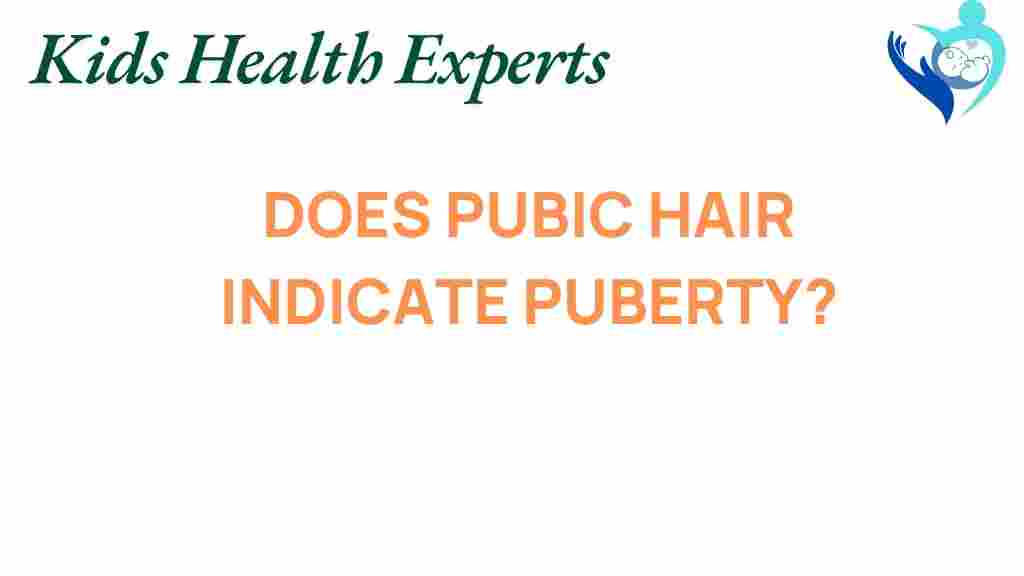Unveiling the Mystery: Does Pubic Hair Signal Puberty?
Puberty is a significant stage in human development, marking the transition from childhood to adulthood. One of the most noticeable changes during this period is the growth of pubic hair. Understanding the relationship between pubic hair and puberty is essential for adolescents, parents, and educators alike. This article will explore the science behind these body changes, the hormonal shifts involved, and the implications for health education and adolescent development.
What is Puberty?
Puberty is a complex process that involves a series of physical, emotional, and psychological changes. It typically begins between the ages of 8 and 14 in girls and 9 and 15 in boys. These changes are driven by hormonal shifts that trigger various developments in the body.
The Role of Hormones in Puberty
During puberty, the body undergoes significant hormonal changes. Key hormones involved include:
- Estrogen: Predominantly in girls, estrogen leads to breast development, the start of menstruation, and the growth of pubic hair.
- Testosterone: In boys, testosterone is responsible for the growth of facial hair, deepening of the voice, and increased muscle mass, along with the development of pubic hair.
- Growth Hormone: This hormone contributes to overall growth, including height and muscle development.
Understanding Pubic Hair Growth
The appearance of pubic hair is one of the earliest signs of sexual maturity and is a key indicator of puberty. Typically, pubic hair growth begins a few years after breast budding in girls and after testicular enlargement in boys. The growth patterns may vary, but the presence of pubic hair signifies that the body is undergoing significant changes.
Stages of Pubic Hair Development
Pubic hair development can be categorized into several stages:
- Stage 1: No pubic hair (pre-puberty).
- Stage 2: Sparse, fine, and straight hair along the labia or scrotum.
- Stage 3: Hair becomes darker, coarser, and curlier, spreading over a larger area.
- Stage 4: Thick, curly hair that does not yet cover the entire area of an adult.
- Stage 5: Adult-type hair that extends to the inner thighs and forms a typical adult pattern.
Health Education and Awareness
Understanding the changes that occur during puberty is crucial for both adolescents and their guardians. Health education plays a pivotal role in fostering awareness about these body changes. Here are some key points to consider:
- Open Communication: Parents should encourage discussions about puberty and body changes to help reduce anxiety and misconceptions.
- Educational Resources: Schools should provide comprehensive health education that covers puberty, sexual maturity, and hygiene.
- Support Systems: Establishing support systems can help adolescents navigate the challenges of growing up.
Common Questions About Pubic Hair and Puberty
1. Is it normal for pubic hair to grow at different rates?
Yes, it is entirely normal for individuals to experience variations in the timing and rate of pubic hair growth. Factors such as genetics and overall health can influence these changes.
2. Can the lack of pubic hair growth indicate a problem?
While some delays in pubic hair development can be normal, particularly in late bloomers, significant delays may warrant a discussion with a healthcare provider to rule out any underlying issues.
3. Should adolescents be concerned about grooming pubic hair?
The decision to groom pubic hair is personal and should be made based on individual comfort and preference. It’s essential to practice safe grooming techniques to avoid irritation or injury.
Step-by-Step Guide: Understanding Body Changes During Puberty
Step 1: Recognizing Signs of Puberty
Awareness of the signs of puberty can help adolescents understand their bodies better. Look for:
- Growth spurts
- Development of secondary sexual characteristics
- Changes in body odor
- Menstrual cycles in girls
Step 2: Understanding Hormonal Shifts
Learn about how hormones affect your body. Understanding the roles of estrogen and testosterone can demystify many changes during puberty.
Step 3: Seeking Reliable Information
Use trusted resources to learn about puberty. Websites like KidsHealth provide reliable information tailored for young audiences.
Step 4: Communicating with Trusted Adults
Encourage open conversations with parents, guardians, or health educators. Discuss any questions or concerns regarding body changes.
Step 5: Practicing Healthy Habits
Maintaining a balanced diet, regular exercise, and good hygiene practices can support healthy growth and development during puberty.
1. Feeling Anxious About Changes?
It’s normal to feel anxious about the changes happening in your body. Here are some tips to manage that anxiety:
- Practice deep breathing techniques.
- Engage in physical activities that you enjoy.
- Talk to friends who may be experiencing similar changes.
2. Questions About Body Image?
Adolescents may struggle with body image during puberty. Consider these strategies:
- Focus on the positives of your body and what it can do.
- Avoid comparing yourself to others on social media.
- Seek support from trusted adults if body image concerns persist.
3. Need Help with Hygiene Practices?
Maintaining hygiene during puberty is crucial. Here are some tips:
- Shower regularly to keep your body fresh.
- Use deodorant to manage body odor.
- Wear breathable underwear to keep the area dry.
Conclusion
In conclusion, the appearance of pubic hair is a significant marker of puberty, signaling the beginning of sexual maturity and various body changes. Understanding these changes, alongside the hormonal shifts that accompany them, is essential for healthy adolescent development. By fostering an environment of open communication and comprehensive health education, we can empower young individuals to navigate this transformative stage with confidence and awareness.
For more information on puberty and adolescent health, consider visiting HealthyChildren.org, which offers extensive resources on raising healthy adolescents.
This article is in the category Growth and created by KidsHealthExperts Team
